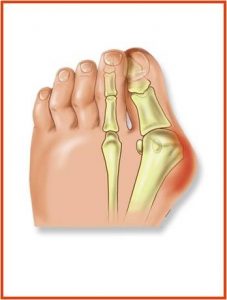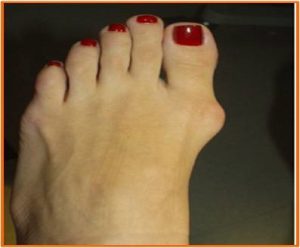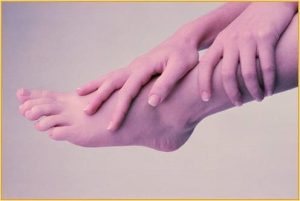A bunion is an enlargement of the joint at the base of the big toe,the metatarsophalangeal (MTP) joint,that forms when the bone or tissue at the big toe joint moves out of place. The toe is forced to bend toward the others, causing an often painful lump of bone on the foot. Because this joint carries a lot of the body’s weight while walking, bunions can cause extreme pain if left untreated. The MTP joint itself may become stiff and sore, making even the wearing of shoes difficult or impossible. A bunion can also occur on the outside of the foot along the little toe, where it is called a “bunionette” or “tailor’s bunion”.
Bunions form when the normal balance of forces that is exerted on the joints and tendons of the foot becomes disrupted. This disruption can lead to instability in the joint and cause the deformity. Bunions are brought about by years of abnormal motion and pressure over the MTP joint. They are, therefore, a symptom of faulty foot development and are usually caused by the way we walk and our inherited foot type or our shoes.
Many people believe bunions runs in families, but it is actually the foot type, not the bunion, which is inherited. Parents who suffer from poor foot mechanics can pass their problematic foot type on to their children, who in turn are prone to developing bunions. The abnormal functioning caused by this faulty foot development can lead to pressure being exerted on and within the foot, often resulting in bone and joint deformities such as bunions and hammertoes. Screening your children at a young age with early intervention, including shoe inserts, may help your children from developing painful bunion later in life.

Other causes of bunions are foot injuries, neuromuscular disorders, or congenital deformities. People who suffer from flat feet or low arches are also prone to developing these problems, as are arthritic patients and those with inflammatory joint disease. Occupations that place undue stress on the feet are also a factor; ballet dancers, for instance, often develop the condition.
When to seek medical attention:
Bunions tend to develop redness, swelling, and pain near the affected joint. Pain is usually present while wearing certain shoe gear and while walking. If you are feeling pain in your foot, you should seek the medical care from a trained podiatrist before your symptoms progress. Bunions tend to get larger and more painful if left untreated, making non-surgical treatment less of an option.
When early treatments fail or the bunion progresses past the threshold for such options, podiatric surgery may become necessary to relieve pressure and repair the toe joint. Several surgical procedures are available to our podiatrists. The surgery will remove the bony enlargement, restore the normal alignment of the toe joint, and relieve pain.

How to prevent bunions:
There are some steps that may help prevent, or at least slow, the progression of bunions:
- Avoid shoes with a narrow toe box
- If your foot flattens excessively, make sure you wear supportive shoes, and if necessary, you may require a pair of our custom foot orthotics to help change the mechanics of your foot while walking.
- Come see one of our well trained podiatrists as soon as you start to notice symptoms of bunion pain. This will allow us to help prevent the further progression of your deformity.